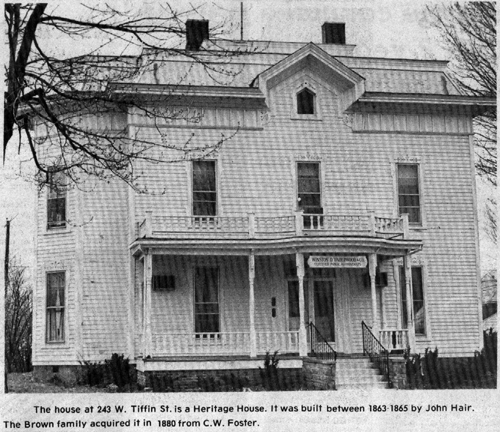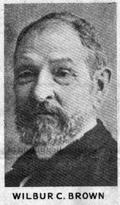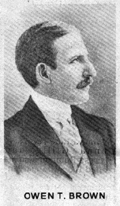May 19, 1983



Picture #1 – The house at 243 W. Tiffin Street, is a Heritage House. It was built between 1863-1865 by John Hair. The Brown family acquired it in 1880 from C.W. Foster.
Picture #2 – Wilbur C. Brown
Picture #3 – Owen T. Brown
Author’s Note: This is an overdue article about another Heritage House in Fostoria, a project designating houses 100 years or older, fostered by the Antique Study Club. Today’s article is the first in a series of two.
Here’s a tale about an old house and a still older family, the Browns, of which most readers of this column never heard.
The house is at 243 W. Tiffin St. and has been there about 118 years. Presently, the property is owned by Winston Underwood, where offices for his certified public accounting business are located. The upstairs of the property is an apartment where Mr. and Mrs. Terrance Hoening reside.
Much more lengthy and interesting is the story about the family, its origin, the business pursuits of father and son here and elsewhere and hose one of the daughters of this famous family spent her last years in rented rooms in Fostoria.
William McKinley, who became the 24th president of the United States, made a speech from the front porch of the house when he was seeking the office.
the house in today’s story, was acquired by Owen T. Brown in 1880, having arrived in Fostoria in 1875, at age 40. His contributions to business, politics, his church, the city and county at large were myriad, according to the records set down in the Centennial Biographical History of Seneca County, published in 1902.
Photographs of Owen T. Brown and his famous son, Wilbur C., were copied from that history and show the flourishing signatures of both, used to authenticate many letters and documents of their activities.
OWEN T. BROWN
Born in Montgomeryshire, Wales, on March 27, 1835, to Edward and Margaret (Williams) Brown. Owen was only seven years old when he and his parents crossed the Atlantic in 1842, settling in Neward Township, Licking County.
Owen’s parents remained in Licking County and he (Owen) attended the schools of Newark, eventually becoming connected with the grain trade there.
In 1874, Owen Brown moved to Fostoria, but continued in buying and selling grain in Newark as a member of the firm, Brown Brothers.
Upon arriving in Fostoria, he became a partner in Foster Olmsted & Company, Foster being Charles who became governor of Ohio and secretary of the U.S. Treasury. Brown continued his connection with them until 1890, when he went to Europe. A reorganization founded Brown & Bannister, which continued until 1896, when Brown became the sole owner.
Brown, in July 1899, became president of the Mechanics Banking Company. Under his direction, the newly-reorganized bank, with conservative business policies, made remarkable progress.
Twice, Mr and Mrs. Owen (Eleanor) Brown revisited their native land, Wales, she having been born in Cardiganshire on March 27, 1835. In 1901, they traveled all over Europe visiting the principal points of modern, as well as historic interest.
Four children were born to them, but Edward, their first, died at age six. The other children were: Wilbur Charles, born in Newark in 1863; Anna M., born in Newark in 1869, died in Fostoria 1929, buried in Fountain Cemetery; and Mamie E., born in Newark in 1869, died in Fostoria 1954, buried in Fountain Cemetery.
Owen T. Brown and his wife both died in Fostoria and are buried in Fountain Cemetery, he March 24, 1904, and she on Feb. 14, 1910.
Mr. Brown was active and influential in promoting progress in building of Fostoria. He served three terms as a member of the city council and president of the board when the city waterworks was built and contracts for city paving were given. The waterworks plant cost $200,000. Brown was a Republican.
He was a member of the Masonic fraternity and the Presbyterian Church serving as a trustee for 36 years.
MANY OWNED PROPERTY
Unfortunately, Winston Underwood, the present owner of the property at 243 W. Tiffin St., did not acquire the original abstract. This author erred in presuming that Owen T. Brown had the house built after he moved to Fostoria. A search of the records at the Seneca County Courthouse, Tiffin, disclosed otherwise.
the lot upon which the house was built was known as No. 290 as far back as 1862, when it was owned by James Anderson.
Anderson sold the lot to John Hair August 13, 1862 for $250. Sometime between that date and November 28, 1865, Hair sold the property to Esther and Randal Hale for $2,500. So, the dollar amount of that sale clearly indicates that a house had been erected on the lot by 1865, perhaps even earlier and without doubt, it was the same house that stands on that lot now.
The Hales sold the property to Anna B. Jones in 1870 for $2,600, and she in turn selling to A. Emerine in 1876 for an undisclosed sum.
In 1880, Emerine sold the property to C.W. Foster, who then sold it to Owen T. Brown that same year.
BROWN’S FAMOUS SON
Wilbur Charles Brown was born November 20, 1862, in Newark, Licking County. He received his preliminary education in the public schools of that place and Fostoria, to which his parents moved in his early youth. In 1880, he graduated from Fostoria High School with highest honors. He was the founder of the Fostoria High /school Alumni Association.
Early in Brown’s life, he manifested an interest and capacity for literary works and at age 14, edited and printed an amateur newspaper. After leaving school, he accepted the position of city editor of the Daily Jeffersonian, Findlay, holding that position for two years.
In April 1882, he entered the banking house of Hon. Charles Foster in Fostoria. Foster was governor then his association with the bank continued until January 1, 1882 when he became treasurer and general financial manager of The Harter Milling Co., Fostoria, which had been organized by Hon. M.D. Harter. At that time, the Harter Milling Co. was the largest winter-wheat milling plant in the U.S.
In 1896, excessive work and responsibility he inherited by the tragic death of Mr. Harter resulted in Brown’s suffering a severe attack of congestion of the brain, however, he escaped fatal termination. After recuperating, he resigned his position at Harter Milling.
Later, Harter Milling Co. became today Mennel Milling Co.
Brown, then became associated with Hon. Abner McKinley, brother of President William McKinley and immediately moved to New York City where he rapidly became involved in various financial endeavors. He was one of the syndicate of capitalists who built the Detroit and Northern Railroad, of which he was treasurer, and member of another syndicate that organized the International Fire Engine Co. He was also one of the largest stockholders in the American Mutoscope Co.
In Fostoria, he organized the Fostoria Shade and Lamp Co., which at that time was one of the largest of its kind in the U.S. Brown was also a director and large stockholder in the White Mountain Paper Co., capitalized at $25 million.